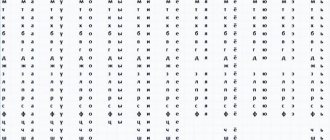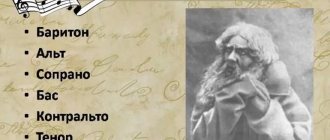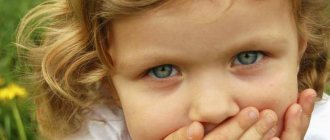VIOLATION OF THE SYLLABAL STRUCTURE OF THE WORD
Correction of the cardiovascular system is one of the priority tasks in speech therapy work with preschoolers with systemic speech disorders. The formation of the CVS affects the success of mastering the grammatical structure of speech, mastering sound analysis, writing, and reading.
Every year the number of children suffering from TSD increases. Most of them have, to one degree or another, a violation of the syllabic structure of the word (SWS). In speech therapy work with children, overcoming shortcomings in sound pronunciation is often highlighted and the importance of the development of the cardiovascular system is underestimated. Difficulties in pronouncing individual sounds, as well as focusing on overcoming them, lead to the fact that the sound, and not the syllable, becomes the unit of pronunciation. This is somewhat contrary to the natural process of speech development. Therefore, it is of particular importance to determine the correct relationship between the development of sound pronunciation and mastery of the syllabic structure of a word. Correction of the cardiovascular system is one of the priority tasks in speech therapy work with preschoolers with systemic speech disorders. The formation of the CVS affects the success of mastering the grammatical structure of speech, mastering sound analysis, writing, and reading.
Since this topic has not been sufficiently studied and covered in educational and methodological literature, speech therapists experience difficulties in organizing work on the formation of the syllabic structure of a word: in systematizing and selecting speech didactic material, providing classes with lexical richness.
This manual presents a system of working on the syllabic structure of a word, based on an analysis of the literature on this problem and on personal teaching experience.
Types of violations of the syllabic structure of words
A.K. Markova identifies the following types of violations of the syllabic structure of a word:
- Violation of the number of syllables:
- Abbreviation (omission) of a syllable: “skein” - hammer;
- Omission of the syllabic vowel: “pinino” - piano;
- Increasing the number of syllables by inserting vowels into consonant clusters: “komanata” - room;
- Violation of the sequence of syllables in a word:
- Rearrangement of syllables: “devore” - tree;
- Rearrangement of sounds of adjacent syllables: “hebemot” - hippopotamus;
- Distortion of the structure of an individual syllable:
- Abbreviation of consonant clusters: “tul” - chair;
- Insertion of consonants into a syllable: “limont” - lemon;
- Similarity of syllables : “coconuts” - apricots;
- Perseverations (cyclical repetition of one syllable).
- Anticipations (replacing previous sounds with subsequent ones): “nananas” - pineapples;
- Contaminations (mixing elements of words): “booth” - kennel + booth.
Stages of working on the syllabic structure of a word
For the formation of the syllabic structure of a word, such non-speech processes as optical-spatial orientation, the possibility of tempo-rhythmic organization of movements and actions, and the ability to serially process information are significant. These non-speech processes are the basic prerequisites for the acquisition of the syllabic structure of a word.
Corrective work to overcome CVS disorders can be divided into 2 stages:
- preparatory, the purpose of which is to prepare the child to master the rhythmic structure of words in his native language; work is carried out on non-verbal and verbal material;
- proper correctional, the purpose of which is the direct correction of cardiovascular system defects in a particular child; work is carried out on verbal material.
Preparatory stage
The preparatory stage includes work in the following areas:
- formation of spatial concepts and optical-spatial orientation;
- development of temporal-spatial orientation;
- development of dynamic and tempo-rhythmic organization of movements.
Below are sample games and exercises to develop these functions. At the preparatory stage, these games and exercises can be used simultaneously, that is, all areas of work can be included in one lesson. Exercises are used not only in speech therapy classes, but also in classes on the development of elementary mathematical concepts, in music classes, in drawing, physical education, and in classes to familiarize themselves with the outside world.
- Formation of spatial representations and optical-spatial orientation
- Orientation in your own body
- “This is what we are like” (“Show your belly, your back”: The belly is in front, the back is behind. Where is the tummy? Where is the back?).
- “Getting things in order” (in front of the child there are mittens, gloves, sandals, etc. - “Find a pair”, “Place the sandals correctly”).
- “Palms and footprints” (The child is offered the outlines of several palms and footprints and the outline of a palm for which he must find a pair from the proposed options).
- Orientation in three-dimensional space
- “Train” (Toys are placed in a column in front of the child and questions are asked: “Who is in front? Who is behind? Who is far away? Who is close?”)
- “Assemble a fairy tale” (In front of the child there is a set of toys or objects: “Place the horse close to the house. Place the little man between the house and the tree.”)
- “Find the treasure” (orientation using diagrams).
- “Where the locomotive is humming” (determining the location of the sound).
- Development of temporal-spatial orientation
- “The bunny went to visit” (The child in the role of a bunny goes, according to the instructions, to visit a squirrel, a hedgehog, a frog. Who had it first, then, at the very end?)
- “What first, what then” (The adult gives the child tasks: 1) first jump, then squat, at the end clap your hands; 2) first rock the bear, then feed the bunny, at the end dress up the doll - the child performs and then describes the sequence of his actions).
- “Look and repeat” (The adult shows a series of movements, the child watches, then repeats all the movements in the desired sequence)
III. Development of dynamic and tempo-rhythmic organization of movements
Areas of work:
- Improving gross motor movements
- Improving fine motor skills
- Development of articulatory motor skills
- Developing a sense of tempo
- Formation of a sense of rhythm
Improving motor skills: general, fine, articulatory
Goal: development of spatial organization of movements; development of switchability of movements; development of the ability to reproduce a given sequence of movements.
- "Do as I do"
The speech therapist performs a series of first two, then three or four movements, the children follow the instructions: “Do as I do”, “Continue yourself”: 1) Sit down - stand up, sit down - stand up, ... 2) Hands to the sides - on the belt, in sides - on the belt, ...3) Leg forward - back - to the side, forward - back - to the side.
- "Skillful Hands"
Alternation of different poses: 1) Fists - palms, ... 2) Rings - ears - horns, ... 3) Fingers say hello.
- Articulation exercises
Alternation of different poses of the organs of the articulatory apparatus: 1) “Frog” - “Proboscis” - “Donut”; 2) “Watch”; 3) “Spatula” - “Needle”.
Developing a sense of tempo
Goal: to teach to distinguish, reproduce, characterize tempo based on tactile-kinesthetic, visual, and auditory sensations.
- "Mouse and Cat"
An adult shows the children how easily and quickly a mouse runs on its toes, and a cat slowly sneaks behind it. The movements are performed in a circle to the sound of a tambourine. For frequent blows - quickly, like a mouse, for rare blows - slowly, calmly, like a cat.
- "Fists - palms"
An adult reads a poem, and children perform hand movements at the right pace:
Anyone has two fists, hit one lightly on the other
Knock - knock, knock - knock.
Well, the palms don’t lag behind, they beat them cheerfully:
Clap - clap, clap - clap.
The fists beat faster, how hard they try:
Knock - knock - knock, knock - knock - knock,
And the palms are just there, crumbling:
Clap - clap - clap, clap - clap - clap.
Formation of a sense of rhythm
Goals: to teach to perceive metric relationships (accented unaccented beats are a prerequisite for mastering stress), to distinguish and reproduce rhythm based on tactile-kinesthetic, visual, and auditory sensations.
- “Thunder” (clap your hands loudly, or quietly, leaning on the drawing - a large cloud - a loud clap, a small cloud - a quiet one).
- Graphic switching exercises: “Beads” (alternating beads of different colors - for example, red - yellow - red - yellow, etc.), “Path” (alternating two or three geometric shapes, various objects).
- Reproduction of rhythms based on clarity, on patterns: “Snowflakes”, “Rain”, “Woodpecker” (“Rain” - a large drop - a long clap, a small drop - a short one).
- Reproduction of a given ri
The adult has wooden spoons in his hands, the children stand in a circle. An adult walks around the circle and sings: Gray Little Bunny has come to visit. The little gray bunny found a spoon. I found the spoons and went up to the house. He stops behind the child and knocks on the spoons: knock - knock - knock. The child asks: “Who’s there?” The adult replies: “It’s me, Bunny, and who are you?” The child answers: “….” The adult continues: “Come on... come out and knock on the spoons with me!” The adult plays the child on the spoons with any of the proposed rhythms: / //; // /; // //; / // / etc.
Corrective stage
Corrective work is carried out on verbal material and consists of several levels. The transition to the next level occurs after mastering the material of the previous level.
The following levels are distinguished:
- level of vowel sounds;
- syllable level;
- word level;
- level of short sentences;
- level of pure proverbs, poems and other texts.
Particular importance at each level is given to “inclusion in work” in addition to the speech analyzer, also the auditory, visual and tactile ones. Below are suggested exercises for each level.
Working on vowels
- Pronouncing a series of two, three or more sounds:
- accompanied by symbols (“Men - sounds”)
- without visual support.
- Pronunciation of a number of vowels with emphasis on one of them (also - with support for clarity and without it - by ear).
- Recognition and pronunciation of a series of vowels from the silent articulation of an adult.
- "Musical Ball"
An adult, throwing a ball to a child, makes one or two (at the next stage more) sounds. The child repeats and returns the ball.
- Pronouncing a series of vowels, changing the volume, tempo, “mood” (sad, angry, affectionate) of the voice.
- Pronounce as many vowels as there are flowers in the meadow.
- Stand up when a series of two (or other specified number) sounds sounds.
Working on syllables
Work is carried out with different types of syllables:
- with a common consonant (for example, the exercise “Rolling a snow woman” - imitating the movements, pronounce: ba - bo - bu - would);
- with a common vowel (ka - ta - ma - va);
- reverse syllables (Say “Aw - aw” as many times as there are dots);
- closed syllables, their rows and pairs (various onomatopoeias);
- direct and reverse syllables with oppositional sounds: according to hardness - softness, sonority - deafness (“We hammer in nails with a hammer: ta - yes - ta - yes, then - to - to - to");
- syllables with confluence.
Techniques and exercises:
- “Musical ball” (see “Working on vowels”)
- The combination of pronouncing syllabic rows with any rhythmic movement: with drawing or tracing broken lines; with laying out sticks and circles; with drawing patterns with a finger in cereals poured into a small box.
- Working with rhythmic patterns (Exercise “Chicken”: the child is offered a rhythmic pattern // / // / /// / /, he needs to voice it: ko-ko ko ko-ko ko ko-ko-ko ko ko).
Working on the word
A.K. Markova identifies the following types of syllabic structure of a word:
- Two-syllables from open syllables (willow, children).
- Three-syllables made of open syllables (hunting, raspberries).
- Monosyllabic (house, poppy).
- Two-syllables with a closed syllable (sofa, furniture).
- Two-syllables with a cluster of consonants in the middle of the word (bank, branch).
- Two-syllable words made from closed syllables (compote, tulip).
- Three-syllable words with a closed syllable (hippopotamus, telephone)
- Three syllables with a consonant cluster (room, shoes).
- Three-syllables with a consonant cluster and a closed syllable (ladle).
- Three-syllable words with two clusters of consonants (matryoshka).
- Monosyllabic words with a consonant cluster at the beginning of a word (table).
- Monosyllabic words with a confluence at the end of a word (umbrella).
- Two-syllables with two consonant clusters (button).
- Four-syllable words made from open syllables (turtle, piano).
Work on words is carried out sequentially - the transition to words of a more complex syllabic structure is carried out as words of the previous type are mastered.
Games and exercises used in the process of practicing words with different types of syllable structure
- Syllable tracks (there are traces on the tracks - depending on the number of syllables in the word - the child says the word, stepping on each syllable to the next trace).
- Syllable lines.
- Syllabic houses (1. The number of syllables corresponds to the number of floors in the house - 3 houses with different numbers of floors - the child pronounces the word, counts the syllables and puts the picture in the desired house. 2. The number of syllables in the distributed words depends on the inhabitants of the houses: cancer - 1 syllable, rooster - 2, frog - 3 syllables).
- “House - castle - hut” (distribution of words depending on the number of syllables in these buildings: to the house - words of one syllable, to the castle - two-syllable words, to the hut - words consisting of 3 syllables).
- “Clock” (find and show with an arrow words of two (1, 3, 4) syllables)
- “Think of a word” (match a word to the diagram - with or without reference to pictures, for example, SA _; SA _ _)
- “Steam locomotive” (a steam locomotive consists of several carriages, the carriages differ in the number of windows, depending on this the words are distributed - in a carriage with one window there are monosyllable words, with two - two-syllable words, etc.).
- “TV” (Visual aid “TV”. There are 1-4 vowel letters on the screen. The child is offered pictures. You need to choose a picture that matches the pattern on the screen. For example, on the screen are the letters U A. And pictures to choose from: house, pear, rose) .
Working on phrases, sentences, texts
- “Additions” (Pictures in front of the children. The adult starts, the child finishes, and then repeats the phrase. For example, prickly... (hedgehog); airy... (balloon); cunning... (fox)).
- “Snowball” (The words are accompanied by movements of the hands from top to bottom, how many words, so many movements, as if “walking along the steps.” The number of words gradually increases. Each time we begin to “step” from top to bottom again. For example: Bird. A bird is flying. A beautiful bird is flying bird. A beautiful little bird is flying.).
- Work on pure sayings, nursery rhymes, jokes, poems.
Material used by the author: Elena Rudolfovna Melyukhina, speech therapist teacher, Maria Aleksandrovna Brukovskaya, speech therapist teacher.
The series of syllables proposed for reproduction should consist of sounds that are well pronounced by the child.A sequence of syllabic exercises with their gradual complication due to the constituent elements:
a) straight syllables with the same vowels: MA-PA-TA;
b) straight syllables with the same consonants and different vowels: TA-TO-TU;
c) reverse syllables with different consonants: AP-AM-AH;
d) reverse syllables with different vowels and consonants: OP-UH-AM;
e) closed and open syllables with different vowels and consonants: PA-AM-AH, AT-FO-UH-EI.
In addition, the number of syllables to memorize gradually increases from two to four; At first they are pronounced slowly, but gradually the pace of speech accelerates. During differentiation, related sounds are included in syllables: RA-LA-RA-LA..., LO-RO-LO-RO; a more complex task is a series of syllables with a modified sequence of constituent elements: RA-LA-LA-RA, LO-RO-LO-LO, RU-RU-LU-RU, etc.
Game techniques for working with syllables
1. “Don’t miss a syllable.”
Children are asked to show a symbol figure (ball, flashlight...) when a given syllable is heard among others, for example MA: MA-PA-TA-MA-FA-MA-VA-KA-MA... To avoid recognizing a syllable by lip articulation, the teacher covers his mouth with a screen.
2. “Living syllables.”
Three children memorize one syllable each and go behind the screen, and when leaving there, pronounce them; the rest of the guys determine which syllable was the first, second and third. Later, syllables that make up a word are introduced into the games, for example MA-SHI-NA; after naming the syllable series, the children answer what happened, or find such a picture among others.
3. "Chain".
The syllables are pronounced in turn: PA-TA-MA-PA-TA-MA... TO-PU-AH...
4. “Count.”
The children clap and reproduce the number of syllables they hear.
5. “Remember someone else’s voice.”
The teacher shows images of animals and birds; children pronounce onomatopoeia, for example, cow, ram and chicken: MU-BE-KO-VO; the pictures are removed, the syllables are repeated from memory.
6. “Which syllable is extra?”
Syllable series: KO-KO-KU-VO, AH-AH-AH-AH.
7. “Memorize and repeat.”
Children memorize three or four syllables with oppositional sounds, each new syllable series begins with a syllable in which there are other consonant and vowel sounds: SA-ZA-ZA-SA, ZO-ZO-SO-ZO, SU-ZU-SU-SU .
Exercises for analyzing rows of isolated vowels and syllables are preparatory exercises that make it easier to recognize sounds in words and divide words into syllables.
Games for recognizing sounds in words
1. “Show a picture (toy, object).”
Children point with their hand to the symbol in front of them in accordance with the sound specified in the word.
2. “Show me a flashlight (bell, mushroom).” Having heard the given sound, the child picks up the figurine in his hand.
3. “Imagine.”
Children respond with predetermined onomatopoeia: on K - cuckoo, on 3 - mosquito...; imitation of movements: F - flight of a beetle, Sh - hissing of a snake, hand “crawls” on the table.
4. “Name it.”
While completing the task, the child pronounces a word beginning with a given sound, for example Ш - step.
5. “Find the same sound.”
A series of words are pronounced, the children identify the repeating sound: owl, braids, nose—S.
6. "Stop."
Kids walk in a circle, imitate the flight of butterflies, the movement of a train... The teacher pronounces words with or without a given sound at the same pace and rhythm, with the same intonation, adding “one, two.” Children stop only on the count of “two” when they hear the sound being studied, otherwise they continue walking. The guys who made a mistake stand at the end of the row.
7. “Choose wisely.”
Among four or five pictures, the child finds those whose names contain a given sound.
8. “Sound at the end (in the middle, at the beginning).”
Pictures with a specific sound position in the title are selected.
9. “Divide by three.”
Depending on the position of the sound in the title, the pictures are divided into three piles.
10. “Where is the sound?”
Three chairs are placed in a row, a child stands in front of each (beginning, middle and end of the row). The adult names the sound and pronounces words containing this sound. A child sits on a chair whose place coincides with the position of the sound in the word.
11. “Who is bigger?”
The child can:
a) select words with a given sound from the plot picture;
b) name surrounding objects with the same sound;
c) remember the names of any objects or pictures with this sound.






